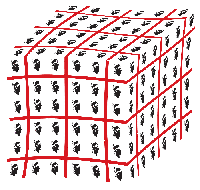Speaker
Kenichi Ishikawa
(Hiroshima University, Department of Physical Science)
Description
The Large Hadron Collider (LHC) experiment has begun to trap the tail of
Higgs boson and to find the evidence of a theory beyoned the standerd model (SM).
Motivated from the unnatural feature of elementary scalar Higgs field,
many models beyond the SM have been proposed and studied.
The technicolor (TC) model is one of them and describes the origin
of electroweak symmetry breaking without introducing elementary scalar particles.
The TC is a scaled-up version of QCD, but should have different fetures
from the simple scaled-up QCD. The most promissing TC models should have
a slowly running (=walking) coupling and a large mass anomalous dimension.
The non-perturavative feature of such models has been investigated using lattice
technique over the last years.
Especially the gauge theories with many fermions, which realizes the walking feature,
are very attractive.
Simulating lattice gauge theory with many dynamical fermions is, however, a heavier task
than that for QCD, since the computational cost is roughly proportional to the number
of dynamical fermions.
Improving the simulation algorithm with many dynamical flavors becomes more important.
In this poster we show the performance improvements on the HMC algorithm
using multiple GPU's suitable to the many flavor simulations.
We also present the preliminary results on the runnning coupling constant
and the mass anomalous dimension for
the $SU(3)$ gauge theory with ten dynamical fermions (ten-flavor QCD) using
the Schroedinger functional method.
| Please, insert your presentation type (talk, poster) | poster |
|---|
Author
Kenichi Ishikawa
(Hiroshima University, Department of Physical Science)
Co-authors
Masashi Hayakawa
(Nagoya University, Department of Physics)
Norikazu Yamada
(KEK and The Graduate University for Advanced Studies (Sokendai))
Shinji Takeda
(Kanazawa University, School of Mathematics and Physics)
Shunpei Uno
(Nagoya University, Department of Physics)
Yusuke Osaki
(Hiroshima University, Department of Physical Science)

